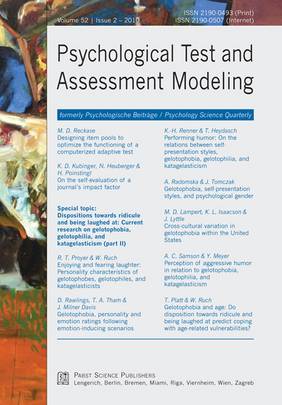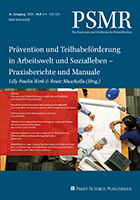Psychological Test and Assessment Modeling, Volume 52, 2010 (2)
Mark D. Reckase
Designing item pools to optimize the functioning of a computerized adaptive test
Abstract |  PDF of the full article
PDF of the full article
Klaus D. Kubinger, Nina Heuberger & Herbert Poinstingl
On the self-evaluation of a journals impact factor
Abstract | ![]() PDF of the full article
PDF of the full article
Special topic:
Dispositions towards ridicule and being laughed at: Current research on gelotophobia, gelotophilia, and katagelasticism (part II)
René T. Proyer & Willibald Ruch
Enjoying and fearing laughter: Personality characteristics of gelotophobes, gelotophiles, and katagelasticists
Abstract | ![]() PDF of the full article
PDF of the full article
David Rawlings, Tsu Ann Tham & Jessica Milner Davis
Gelotophobia, personality and emotion ratings following emotion-inducing scenarios
Abstract | ![]() PDF of the full article
PDF of the full article
Karl-Heinz Renner & Timo Heydasch
Performing humor: On the relations between self-presentation styles, gelotophobia, gelotophilia, and katagelasticism
Abstract | ![]() PDF of the full article
PDF of the full article
Anna Radomska & Joanna Tomczak
Gelotophobia, self-presentation styles, and psychological gender
Abstract | ![]() PDF of the full article
PDF of the full article
Martin D. Lampert, Kate L. Isaacson & Jim Lyttle
Cross-cultural variation in gelotophobia within the United States
Abstract | ![]() PDF of the full article
PDF of the full article
Andrea C. Samson & Yonni Meyer
Perception of aggressive humor in relation to gelotophobia, gelotophilia, and katagelasticism
Abstract | ![]() PDF of the full article
PDF of the full article
Tracey Platt & Willibald Ruch
Gelotophobia and age: Do disposition towards ridicule and being laughed at predict coping with age-related vulnerabilities?
Abstract | ![]() PDF of the full article
PDF of the full article
Designing item pools to optimize the functioning of a computerized adaptive test
Mark D. Reckase
Abstract
Computerized adaptive testing (CAT) is a testing procedure that can result in improved precision for a specified test length or reduced test length with no loss of precision. However, these attractive psychometric features of CATs are only achieved if appropriate test items are available for administration. This set of test items is commonly called an "item pool. This paper discusses the optimal characteristics for an item pool that will lead to the desired properties for a CAT. Then, a procedure is described for designing the statistical characteristics of the item parameters for an optimal item pool within an item response theory framework. Because true optimality is impractical, methods for achieving practical approximations to optimality are described. The results of this approach are shown for an operational testing program including comparisons to the results from the item pool currently used in that testing program.
Key words: computerized adaptive testing, item pool design, item response theory, conditional standard error of measurement, item pool size
Mark D. Reckase, PhD
Michigan State University
461 Erickson Hall
East Lansing, MI 48824, USA
E-Mail: reckase@msu.edu
On the self-evaluation of a journals impact factor
Klaus D. Kubinger, Nina Heuberger & Herbert Poinstingl
Abstract
The self-evaluation of the impact factor of a journal using Google Scholar search is suggested. This allows a less established journal to offer a submitting author some objective information of the journals visibility and reception within scientific community. Though self-evaluation is costly in terms of labor, it is a viable procedure - as illustrated through the example of the journal Psychology Science Quarterly.
Key words: impact factor, Google Scholar, ISI Web of Knowledge
Prof. Klaus D. Kubinger, PhD
Head of the Division of Psychological Assessment and Applied Psychometrics
Faculty of Psychology
University of Vienna
Liebiggasse 5
A-1010 Vienna, Austria, Europe
E-Mail: klaus.kubinger@univie.ac.at
Enjoying and fearing laughter: Personality characteristics of gelotophobes, gelotophiles, and katagelasticists
René T. Proyer & Willibald Ruch
Abstract
People differ in the way they deal with ridicule. The study examines the personality correlates of those who fear being laughed at (gelotophobes), those who enjoy being laughed at (gelotophiles) and those who enjoy laughing at others (katagelasticists). Gelotophobes do not interpret laughter by others as something positive but more as a mean to put them down. Gelotophiles enjoy being laughed at and interpret the laughter by others positively, as a sign of appreciation. Katagelasticists enjoy laughing at others and do not feel that there is anything wrong in doing so. In an empirical study (N = 394), gelotophobia, gelotophilia, and katagelasticism were related to the PEN-model. Gelotophobes were found to be introverted neurotics. Gelotophilia was primarily related to extraversion and in a multiple regression analysis gender (higher among males) turned out to be predictive as well. Katagelasticists were found to be younger males with higher scores in extraversion and psychoticism. Overall, in a regression analysis the content scales of the short form of the EPQ-R predicted gelotophobia best, but gelotophilia and katagelasticism also yielded robust relations.
Key words: gelotophobia, gelotophilia, humor, katagelasticism, PEN-model, ridicule
René Proyer, PhD
University of Zurich
Department of Psychology
Division for Personality and Assessment
Binzmuehlestrasse 14/7
CH-8050 Zurich, Switzerland
E-Mail: r.proyer@psychologie.uzh.ch
Gelotophobia, personality and emotion ratings following emotion-inducing scenarios
David Rawlings, Tsu Ann Tham & Jessica Milner Davis
Abstract
Using measures of personality and emotion not previously employed in gelotophobia research, the study investigated the relationship between gelotophobia and emotion ratings after controlling for personality. The relationship between gelotophobia and sensory sensitivity was also investigated. Using the Big Five Inventory to measure personality, and the Highly Sensitive Person Scale to measure sensory sensitivity, the results supported previous research correlating gelotophobia with introversion and neuroticism. Six emotion scenarios were presumed to induce feelings of shame, shyness or embarrassment, and nine emotions were rated using the Differential Emotions Scale. When links to emotion ratings were explored, the research clearly supported previous research indicating the importance of fear. The expected link between gelotophobia and shame was supported for some scenarios, though shame was of slightly less relevance than sadness and guilt in the present study. It is suggested that subtle aspects of the situation, including the scenarios, the ratings measures, and the cultural background of the participants, may have contributed to the pattern of results.
Key words: emotions, gelotophobia, personality, sensitivity, shame
David Rawlings, PhD
Psychological Science
The University of Melbourne
VIC, 3010, Australia
E-Mail: rawlings@unimelb.edu.au
Performing humor: On the relations between self-presentation styles, gelotophobia, gelotophilia, and katagelasticism
Karl-Heinz Renner & Timo Heydasch
Abstract
This paper investigates relations of self-presentation styles with gelotophobia (fear of being laughed at), gelotophilia (joy of being laughed at) and katagelasticism (joy of laughing at others). It is argued that presentational capabilities are often necessary to effectively perform jokes and funny stories. Furthermore, humor may be used to convey self-images to interaction partners. Results of an online questionnaire study (N = 643) yielded the hypothesized associations between self-presentation styles and humor-related traits. In particular, the histrionic self-presentation style that is characterized by performing explicit As-If-behaviors in everyday interactions showed incremental validity in predicting gelotophilia and katagelasticism over and above gender, age and two other self-presentation styles. The same incremental validity in predicting gelotophobia emerged for the protective self-presentation style that aims at avoiding social disapproval. The acquisitive self-presentation style (guided by the desire to win social approval) only showed a low positive correlation with gelotophilia, was unrelated to katagelasticism and negatively correlated with gelotophobia. The discussion is focused on the possibility to apply the themes of agency and communion to humor-related traits and self-presentation styles and highlights that research on humor and self-presentation may cross-fertilize.
Key words: humor, histrionic self-presentation style, gelotophobia, gelotophilia, katagelasticism
Prof. Karl-Heinz Renner, PhD
Fern-Universität in Hagen
Department of Psychology
Universitätsstr. 11
TGZ (3. Etage)
58084 Hagen, Germany
E-Mail: karl-heinz.renner@fernuni-hagen.de
Gelotophobia, self-presentation styles, and psychological gender
Anna Radomska & Joanna Tomczak
Abstract
The main research objective was to analyse the relationships between gelotophobia (Ruch & Proyer, 2008a) and self-presentation styles (based on Wojciszke, 2002a; see also Arkin, 1981; Tedeschi & Lindskold, 1976) as well as psychological gender (Bem, 1993). A sample of 200 persons (mostly students) completed the GELOPH<15>, Wojciszkes (2002a) Self-presentation Style Questionnaire, and Kuczyńskas (1992) Sex Role Inventory (i.e., the Polish version of Bems Sex Role Inventory; Bem, 1974). Gelotophobes used primarily self-depreciation self-presentation styles and tended to display a higher number of such strategies in total. Furthermore, they did not use self-promoting self-presentation. Additionally, there was a negative relation to masculine psychological gender. In a regression analysis, self-depreciation and masculinity (negatively) turned out to be potent predictors of the fear of being laughed at (explaining about 40 %). Those with a feminine psychological gender scored higher in gelotophobia than those with masculine, androgynous or undifferentiated gender. Overall, both psychological gender and self-presentation styles were useful variables in the description of gelotophobes.
Key words: gelotophobia, fear of being laughed at, self-presentation style, self-promotion, self-depreciation, psychological gender
Anna Radomska, PhD
Section on Developmental Psychology
Department of Psychology
ul. Stawki 5/7
00-183 Warsaw, Poland
E-Mail: aldona@psych.uw.edu.pl
Cross-cultural variation in gelotophobia within the United States
Martin D. Lampert, Kate L. Isaacson & Jim Lyttle
Abstract
In the first international study of gelotophobia (the fear of being laughed at), Proyer et al. (2009) administered an established measure of gelotophobia, the GELOPH, to 93 different samples across 73 countries, including six samples from the United States. In the original study, the researchers reported notable response similarities across a core set of GELOPH items, referred to as the GELOPH<15>. The present study takes a closer look at ethnic differences within these original United States samples, focusing specifically on the differences between European and Asian American respondents to two types of items on the GELOPH<15>, which we identified as self-perception and social reaction items. Based on prior research dealing with self-concept and social anxiety, we predicted that individuals with a more interdependent self-construal (Asian Americans) would be more likely than those with an independent self-construal (European Americans) to report greater concern over revealing themselves as foolish or ridiculous in public. However, because of the greater importance for their own self concept to maintain positive social relations, Asian Americans would not be more likely than European Americans to report greater avoidance of or discomfort with social encounters involving laughter. Comparisons of the GELOPH<15> items related to self-perceptions and social reactions supported these expectations, and we discuss how these results highlight how sets of items on the GELOPH<15> may vary in their sensitivity to cultural differences.
Key words: phobias, social anxiety, shame, ethnicity, laughter
Martin D. Lampert, PhD
Department of Psychology
Holy Names University
3500 Mountain Blvd.
Oakland, CA 94619, USA
E-Mmail: lampert@hnu.edu
Perception of aggressive humor in relation to gelotophobia, gelotophilia, and katagelasticism
Andrea C. Samson & Yonni Meyer
Abstract
The present study investigates humor appreciation of aggressive cartoons in relation to gelotophobia, gelotophilia, and katagelasticism. These traits were described to have a peculiar relation to laughter-related phenomena, in particular to disparagement humor. 185 participants rated highly aggressive and non-aggressive humorous stimuli for funniness and aversiveness and their scores on the gelotophobia, gelotophilia and katagelasticism scales were measured. The cartoons were controlled for their structural basis, i.e., incongruity-resolution and nonsense humor, as these two types of humor strongly influence the appreciation of humorous stimuli. The results revealed that high scores on gelotophobia lead to higher aversion to aggressive humor, whereas high scores on katagelasticism lead to more enjoyment of aggressive humor with less aversion. Gelotophobia and katagelasticism lead to sensitivity to aggression in humor, which fits the overt behavior of reacting sensitively towards laughter (gelotophobia) and enjoying to laugh at others (katagelasticism). Gelotophilia did not predict reactions to either aggressive or non-aggressive humor but did predict more amusement in general: High scorers on gelotophilia seem to be relaxed towards any form of humor, even if it has an aggressive note. This study confirms the three dimensions to have peculiar responses to aggressive types of humor and opens up several questions to be explored in future research.
Key words: gelotophilia, gelotophobia, katagelasticism, humor, cartoon, aggression
Andrea Samson, PhD
Department of Psychology
Stanford University
450 Serra Mall, Bldg 420
Stanford, CA, 94305, USA
E-Mail: andrea.samson@stanford.edu
Gelotophobia and age: Do disposition towards ridicule and being laughed at predict coping with age-related vulnerabilities?
Tracey Platt & Willibald Ruch
Abstract
The present study examines how dispositions to ridicule and being laughed at (gelotophobic, gelotophilic or katagelasticistic) assist, or hinder, coping with age-related problems or vulnerabilities. A sample of 131 adult participants completed the PhoPhiKat-30, the PPK-Vulnerability Statement Comparison (PPK-VSC), and the Third Age Vulnerabilities Anxiety Survey (TAVAS). Results showed that the PhoPhiKat-30 is a reliable self-report instrument in its English language form. The dispositions to ridicule and being laughed at (as measured by the PhoPhiKat-30) together with education level and amount of worry about actual or potential problems predicted the nature of the response to the age-related vulnerabilities. People of low education, who generally fear being laughed at but who also ridicule others, and have not experienced many age-related vulnerabilities but worry about them, indicate that they would act gelotophobicly when facing such problems. Gelotophilia, higher education and not experiencing worrying vulnerabilities are predictive of a tendency to make others laugh at ones problems. Katagelasticistism, increased age, no education above compulsory schooling, and a higher number of problems encountered but not worried about relates to laughing at the misfortunes of others. The implications of the results for those interacting with older people are discussed.
Key words: age-related problems, gelotophobia, gelotophil
a, katagelasticism, ridicule, life span
Tracey Platt, PhD
Personality and Assessment
Department of Psychology
University of Zurich
Binzmühlestrasse 14/7
8050 Zurich, Switzerland
E-Mail: tracey.platt@psychologie.uzh.ch























